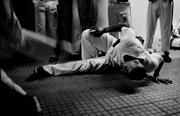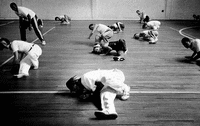




CAPOEIRA
It can be said that Capoeira defies description, that one must witness its magic firsthand to comprehend its energy, beauty, and skill. To understand the movement, music, and magnetism of Capoeira, we must explore the art's fascinating tradition and mysterious history. Capoeira is a story of triumph and freedom.
Rooted in the rich African cultures brought to Brazil by slaves, Capoeira's history, mostly oral, is a subject of much debate.
It is the teachings of old masters and a few surviving documents that tell the story of this singular art. Capoeira's origin dates back 500 years to the beginnings of Brazil's slave trade period. Throughout the 488 year slave trade the Congo, Bantu, and Angolan tribes met and intermingled in the senzalas (slave quarters) and in the quilombos (escape slave nations). From this intermingling of cultures came a melding of traditions and rituals, and Capoeira was born.
Capoeira and its practitioners persevered through centuries of marginalization and discrimination and today the art has evolved from cultural ritual to martial art to way of life. This once clandestine vehicle of physical and spiritual empowerment, has transformed itself into a staple of Brazilian society. What was once outlawed by police is now an international phenomenon. Across the globe in fitness circles, artist communities, on print and television film we see Capoeira's legacy.
In the last few years, Capoeira has taken the world by storm. In the United States it is in demand, rapidly becoming the most sought-after art form and means of creative self-expression. Capoeira promotes diversity and tolerance, teaches discipline and respect for tradition, insures amazing fitness, and encourages investment in culture. Programs exist in over 35 states and in over 50 countries. From coast-to-coast, continent to continent, Capoeira is captivating people of all ages and walks of life.





